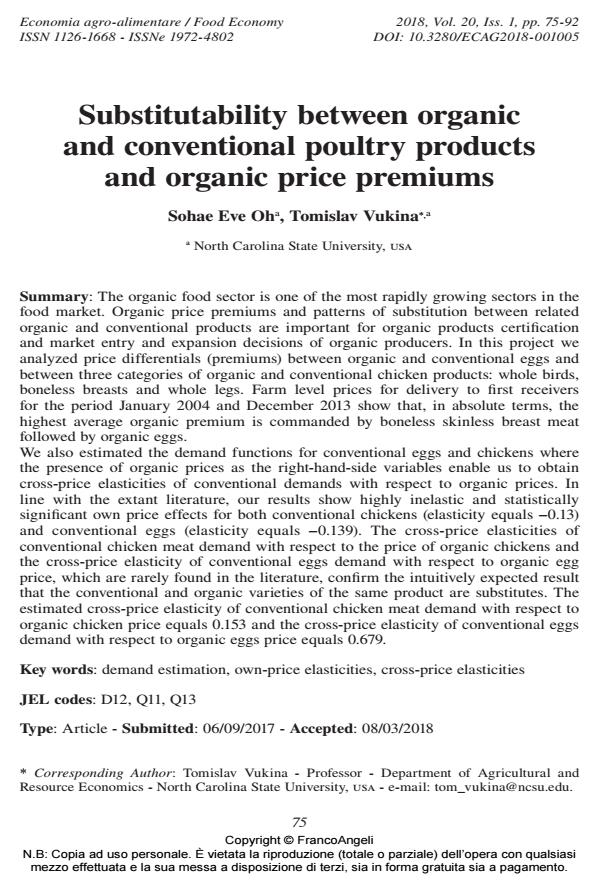Substitutability between organic and conventional poultry products and organic price premiums
Titolo Rivista ECONOMIA AGRO-ALIMENTARE
Autori/Curatori Sohae Eve Oh, Tomislav Vukina
Anno di pubblicazione 2018 Fascicolo 2018/1 Lingua Inglese
Numero pagine 18 P. 75-92 Dimensione file 159 KB
DOI 10.3280/ECAG2018-001005
Il DOI è il codice a barre della proprietà intellettuale: per saperne di più
clicca qui
Qui sotto puoi vedere in anteprima la prima pagina di questo articolo.
Se questo articolo ti interessa, lo puoi acquistare (e scaricare in formato pdf) seguendo le facili indicazioni per acquistare il download credit. Acquista Download Credits per scaricare questo Articolo in formato PDF

FrancoAngeli è membro della Publishers International Linking Association, Inc (PILA)associazione indipendente e non profit per facilitare (attraverso i servizi tecnologici implementati da CrossRef.org) l’accesso degli studiosi ai contenuti digitali nelle pubblicazioni professionali e scientifiche
The organic food sector is one of the most rapidly growing sectors in the food market. Organic price premiums and patterns of substitution between related organic and conventional products are important for organic products certification and market entry and expansion decisions of organic producers. In this project we analyzed price differentials (premiums) between organic and conventional eggs and between three categories of organic and conventional chicken products: whole birds, boneless breasts and whole legs. Farm level prices for delivery to first receivers for the period January 2004 and December 2013 show that, in absolute terms, the highest average organic premium is commanded by boneless skinless breast meat followed by organic eggs. We also estimated the demand functions for conventional eggs and chickens where the presence of organic prices as the right-hand-side variables enable us to obtain cross-price elasticities of conventional demands with respect to organic prices. In line with the extant literature, our results show highly inelastic and statistically significant own price effects for both conventional chickens (elasticity equals -0.13) and conventional eggs (elasticity equals -0.139). The cross-price elasticities of conventional chicken meat demand with respect to the price of organic chickens and the cross-price elasticity of conventional eggs demand with respect to organic egg price, which are rarely found in the literature, confirm the intuitively expected result that the conventional and organic varieties of the same product are substitutes. The estimated cross-price elasticity of conventional chicken meat demand with respect to organic chicken price equals 0.153 and the cross-price elasticity of conventional eggs demand with respect to organic eggs price equals 0.679.
Keywords:Demand estimation, own-price elasticities, cross-price elasticities
Jel codes:D12, Q11, Q13
- Chang, J.B., Lusk, J.L., & Bailey Norwood, F. (2010). The price of happy hens: A hedonic analysis of retail egg prices. Journal of Agricultural and Resource Economics, 35(3), 406-423.
- Oberholtzer, L., Greene, C., & Lopez, E. (2006). Organic poultry and eggs capture high price premiums and growing share of specialty markets. Washington, DC: US Department of Agriculture, Economic Research Service.
- Carlson, A., & Jaenicke, E. (2016). Changes in Retail Organic Price Premiums from 2004 to 2010. No. 242448. United States Department of Agriculture, Economic Research Service. -- Retrieved from: www.ers.usda.gov/publications/err-economic-research-report/err209.
- Glaser, L.K., & Thompson, G. D., (2000). Demand for organic and conventional beverage milk. Western Agricultural Economics Association Annual Meeting, June 29-July, Vancouver, Canada (pp. 1-22).
- Thompson, G.D. (1998). Consumer demand for organic foods: what we know and what we need to know. American Journal of Agricultural Economics, 80(5), 1113-1118. DOI: 10.2307/1244214
- Glaser, L., & Thompson, G.D, (1998). Demand for organic and conventional frozen vegetables. American Agricultural Economics Association Annual Meeting, August 8-11, Nashville, Usa (pp. 1-13).
- Krystallis, A., & Chryssohoidis, G. (2005). Consumers’ willingness to pay for organic food: Factors that affect it and variation per organic product type. British Food Journal, 107(5), 320-343. DOI: 10.1108/00070700510596901
- Dimitri, C. & L. Oberholtzer, (2008). The U.S. Organic Handling Sector in 2004: Baseline Findings of the Nationwide Survey of Organic Manufacturers, Processors, and Distributors. Economic Information Bulletin, Number 36.
- Washington, DC: U.S. Department of Agriculture, Economic Research Service. -- Retrieved from http://www.ers.usda.gov/Publications/EIB36/EIB36.pdf.
- Ibarburu, M. & Bell, D. (2010). Flock Statistics March 2010. U.S. Egg Industry Statistical Report. Ames, IA: Iowa State University, Department of Animal Science, Egg Industry Center.
- Ibarburu, M. & Bell, D. (2012). Flock Statistics January 2012. U.S. Egg Industry Statistical Report. Ames, IA: Iowa State University, Department of Animal Science, Egg Industry Center.
- Malone, T. & Lusk, J.L. (2016). Putting the Chicken Before the Egg Price: An Ex Post Analysis of California’s Battery Cage Ban. Journal of Agricultural and Resource Economics, 41(3), 518-532.
- Mullally, C. & Lusk, J.L. (2017). The Impact of Farm Animal Housing Restrictions on Egg Prices, Consumer Welfare, and Production in California. American Journal of Agricultural Economics. DOI: 10.17605/OSF.IO/CN36M
- U.S. Department of Agriculture, Agricultural marketing service, National Organic program (2011). What is Organic? -- Retrieved from: https://www.amd.usda.gov?sites/default/files/media/What%20is%20Organic.pdf.
- U.S. Department of Agriculture (usda), Economic Research Service (ers) (2017). ‘Table 2--U.S. certified organic farmland acreage, livestock numbers, and farm operations, 1992-2011. Washington, DC: usda. -- https://www.ers.usda.gov/dataproducts/organic-production/.
- Vukina, T., Anderson, K. & Muth, M.K. (2014a). Economic Effects of Proposed Changes in Living Conditions for Laying Hens under the National Organic Program. Journal of Applied Poultry Research, 23(1), 80-93.
- Vukina, T., Anderson, K. & Muth, M.K. (2014b). Proposed Changes in Living Conditions for Broilers under the National Organic Program Will Have Limited Economic Effects. Journal of Applied Poultry Research, 23(1), 233-243.
- How Product Attributes and Consumer Characteristics Influence the WTP, Resulting in a Higher Price Premium for Organic Wine Christine Mauracher, Isabella Procidano, Marco Valentini, in Sustainability /2019 pp.1428
DOI: 10.3390/su11051428
Sohae Eve Oh, Tomislav Vukina, Substitutability between organic and conventional poultry products and organic price premiums in "ECONOMIA AGRO-ALIMENTARE" 1/2018, pp 75-92, DOI: 10.3280/ECAG2018-001005